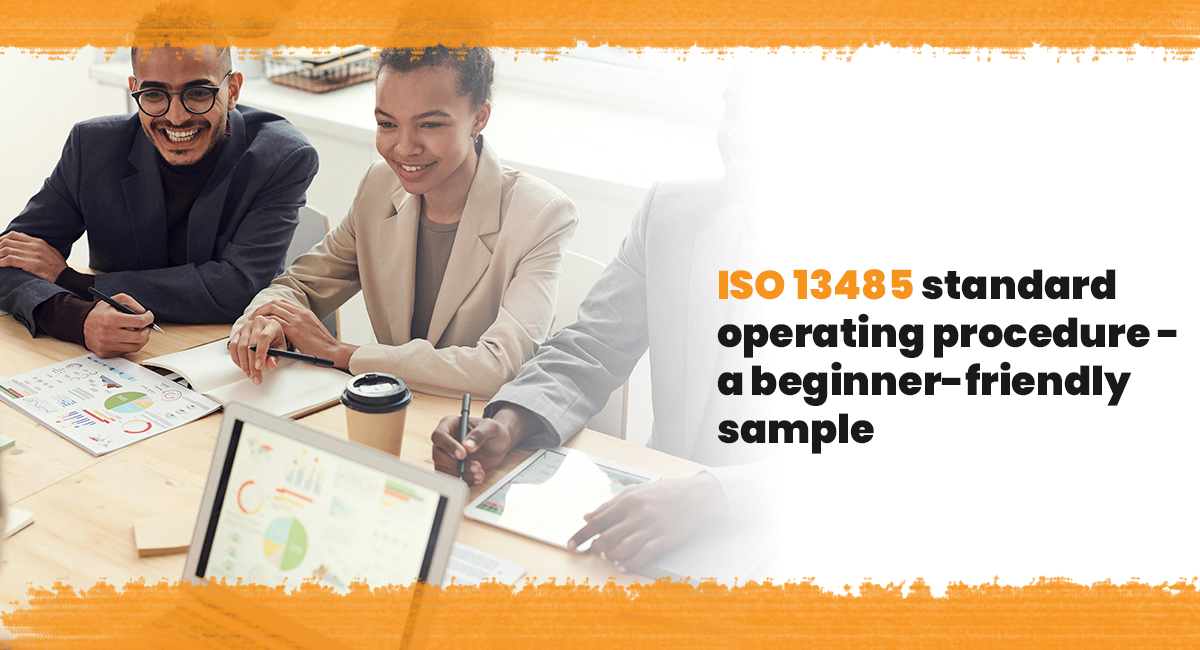ISO 13485 standard operating procedure – a beginner-friendly sample
The ISO 13485 standard operating procedure is not a hectic schedule if you are aware of the fundamentals. The medical device industry is constantly blooming and becoming more competitive. It is quite difficult to beat your rivals without a quality management standard. The ISO 13485 standard is the international benchmark that offers the most relevant framework for improving the performance of your medical devices. You can increase sales and attract new customers by selling premium medical tools. Since the medical industry continues to thrive, the need for effective devices will never be out of demand.
If implemented efficiently, The operating procedures can help improve the overall business model. The following blog provides a sample of the operating procedure for small and medium companies.
A sample of ISO 13485 standard operating procedure
1.Purpose: This SOP (Standard operating procedure) outlines the procedures to ensure compliance with the ISO 13485 standard for the quality management system within the company.
2.Scope: This SOP applies to all departments and personnel involved in the design, development, production, installation, and servicing of medical devices.
3.Definitions: ISO 13485 is an international standard that specifies requirements for a quality management system for medical devices. The standard stands for a quality management system. It defines a structured system of procedures and processes covering all aspects of the production and delivery of products or services.
4.Responsibilities
• Quality Manager: Oversees the implementation and maintenance of the QMS, ensuring compliance with ISO 13485.
• Department Managers: Ensure departmental adherence to the QMS and ISO 13485 requirements.
• Employees: Follow procedures and participate in training to comply with the QMS.
5.Procedure
5.1Document Control: All documents must be reviewed and approved by authorized personnel before implementation. Second, ensure all documents are uniquely identified, current, and available at points of use. Further, the management must review and update documents periodically to reflect changes in processes, standards, or regulations.
5.2Management Responsibility: Top management must demonstrate commitment to the QMS and compliance with ISO 13485. The authority must develop, implement, and maintain a quality policy that aligns with the organization’s objectives and ISO 13485. Finally, the top authority must conduct regular management reviews. They must assess the effectiveness of the QMS and identify areas for improvement. It will help to determine if the implementation has proven effective or not.
5.3Resource Management: Ensure adequate resources (human, infrastructure, and work environment) are available to implement and maintain the QMS. Identify training needs and provide training to ensure personnel are competent. Maintain records of training and qualifications.
5.4 Product Realization: It starts with planning and developing processes needed for product realization under ISO 13485. Next is determining and meeting customer requirements, including regulatory requirements for medical devices. Next is designing an effective set of operations. Establish and maintain a design and development process, including design reviews, verification, and validation. This process follows the purchasing process. Control the buying process to ensure purchased products conform to specified requirements. Finally to determine the product provision, establish a control framework for the production and service processes. It includes validation of processes, identification, and traceability, and preservation of products.
5.5 Measurement, Analysis, and Improvement: It is necessary to check on the progress. The management must establish and maintain procedures for monitoring and measuring processes and product quality. The most applicable practice performing an internal audit. The management can hire expert audit specialists to conduct internal audits to ensure the QMS conforms to ISO 13485. This way the management can determine if the system is effectively implemented and maintained. Next is reducing nonconformity. Establish procedures to control nonconforming products, including identification, documentation, evaluation, segregation, and disposition. According to the findings, it is time for recovery. Implement corrective and preventive actions to eliminate causes of nonconformities and prevent recurrence. Record and review the effectiveness of these actions.
5.6 Risk Management: Conduct risk assessments to identify, analyze, and control risks associated with medical devices throughout their lifecycle. Implement risk control measures and monitor their effectiveness.
6.Records and Documentation: Maintain records to provide evidence of compliance with ISO 13485 requirements and this SOP. Ensure records are legible, identifiable, and retrievable.
7.Review and Revision: This SOP will be reviewed annually and revised to ensure continued compliance with ISO 13485.
To find the best professional support for attaining the ISO 13485 standard operating procedure and the internal audit requirements, contact us at ComplianceHelp Consulting LLC. We are the premium site for achieving any ISO certification in the USA. Our customized solutions for ISO and other global certifications are ready to make the seemingly exhausting accreditation process, comfortable and time-bound. From basic consultation to audit and analysis, we will cover everything. Get help to clear your concepts regarding the clauses of any management system standard you require. Click here to learn more about the service charges.

